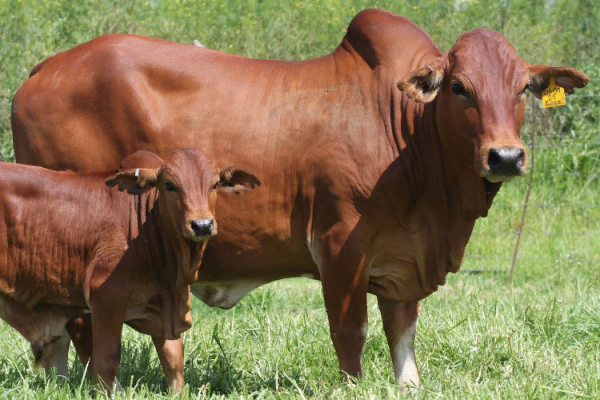

By careful selection and application of the strict standards of excellence of the Boran Cattle breeders Society, the Boran breed has been developed into an ideal beef animal suitable for the arid range areas to be found in many parts of the world.
The original strains of the breed came from Ethiopia and were adopted early in the 20th Century by commercial cattlemen in Laikipia, Machakos and the Rift Valley Districts of Kenya. The Boran society was formed in 1951 and its panel of inspectors continues to ensure that the breed progresses and keeps up to date with the demands of modern beef production. The society promotes exports of embryos world wide and semen is exported throughout the East African region.
Purpose: Meat and milk production
Average body size: Medium (Average live-weight is 350-400 kg)
Description:
The Boran is typically white in colour with dark points and pigmented generally black skin. Steel-grey with black points is not uncommon. Fawn and red also occur, but black is rare and is not considered a true Boran colour. The Breed standard permits all colours except brindle.
The head is carried well, of medium length and slightly convex. Ears are small in comparison with the Indian breeds and not pendulous. Horns are generally short, round in cross- section and upright, but there is some variation in size and length. Polled animals are not uncommon and some animals have been selected for this condition.
The hump is well defined and thoracic; it is larger in the male than in the female. The Boran shows a surprisingly straight top line for a Zebu animal. The well-developed hindquarters have frequently been remarked upon. The rump is long, wide and muscular in the male and the buttocks are well fleshed. Among Zebu breeds the Boran is outstanding in this character. Skin is generally thin, with loose folds and pliable. Both the dewlap and umbilical folds are well developed.
The Boran is generally vigorous and alert. Being accustomed to desert condition, it covers vast distances in search of grazing and water and in some areas is only watered on alternate days or on the third day.
Fertility
Boran produce a calf a year. Even under harsh conditions the Boran cow will continue to breed and rear calves and do this without punishing herself. One explanation for this high fertility is that the cow has relatively low body weight loss over the suckling period, thereby maintaining a good condition, thus able to conceive again.
Longevity
Boran cattle live a long time. It is quite normal for 15 years old breeding cows to be sound mouthed and it is also on record that a 16 year old Boran bull is still producing high quality semen for artificial insemination.
Temperament
Boran cattle are recognized as being generally quiet, docile and easy to handle. This trait has developed over many generations of cattle living close to man.
Beef production and Carcass Quality
Average weight gains per day on grass & feedlot: Grass = 0.7 – 1.0 kg depending on grass quality. Feedlot = 1.3 kg per day depending on type of cross used. Boran and its crosses score consistently better than other Zebu breeds for meat tenderness, carcass marbling and rib eye area. Butchers prefer Borans and their crosses for this reason.
Disease resistance
The Boran has a useful degree of host resistance to ticks and it is reported that the breed is ‘completely resistant to buffalo fly’. Borans are generally less affected by foot and mouth diseases than exotics and recover faster. It is also clear that the morbidity and mortality rates of East Cost Fever are lower in Boran than in Boss taurus breeds; the Boran being naturally more resistant.
Survival Characteristics
Being an animals which in obliged to walk long distances, selection for perfect feet and leg conformation is necessary for registered cattle. The herd instinct of the Boran makes it very easy to manage in bush country. They are noted for being able to ‘graze on the trot’ and they will always stay together.
The cow has a well-carried udder with strong attachments and neat, small teats. Boran heifers reach puberty at an average age of 13 months. She is an excellent mother, not only will she feed her calf so well that high weaning weights are attainable, but she guards against predators, and will never allow her calf to get lost in the bush. Calving problems hardly exist. Calves at birth weigh an average of 28 kg for males and females, 25 kg.
Boran cattle have developed adaptive traits of crucial importance for their survival. Some of these characters are – the ability to withstand periodic shortage of water and feed, ability to walk long distances in search of water and feed and ability to digest low quality feeds.
The well-developed beef conformation shows up in carcass appraisals. The depth of eye muscle, marbling, even fat cover and ratio of hind to forequarter make the Boran difficult to beat, hence the preference of Kenya butchers for young, well-finished Boran steers.
Advantages:
They are docile, their milk has high butter-fat of 4.8% and they are good breeds for marginal areas
Disadvantages:
Milk production potential is low (10 liters/day) and are difficult breeders, mostly mating at night.
 Contact Jaguza Support
Contact Jaguza Support